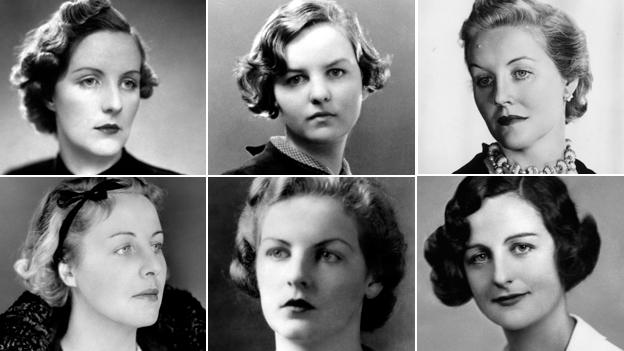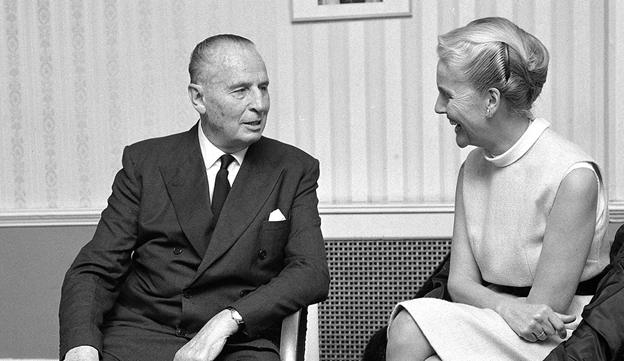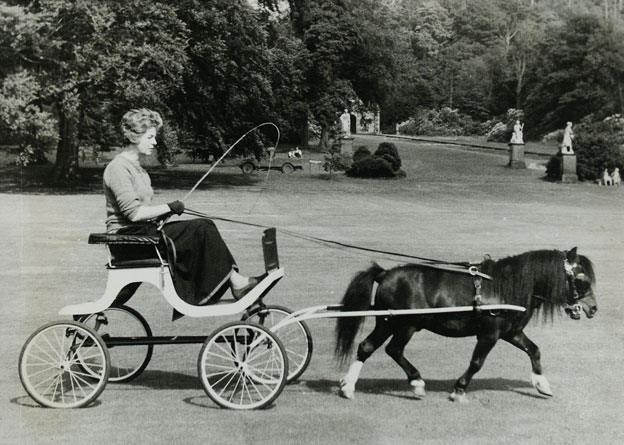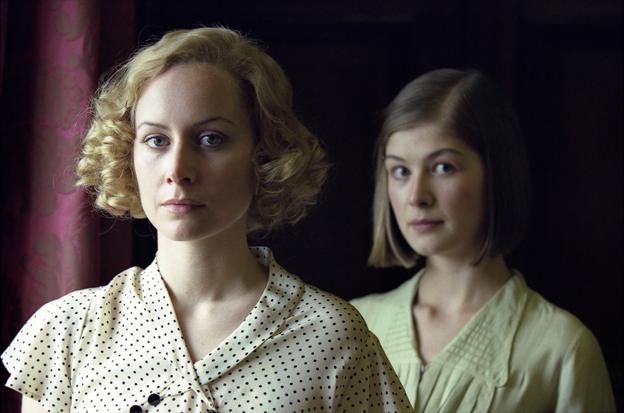The Mitfords: Six sisters who captured the maelstrom
- Published

The Mitford sisters (clockwise from top left): Unity; Jessica; Diana; Nancy; Deborah; Pamela
The death of Deborah Mitford, the Dowager Duchess of Devonshire, signals the end of an era. From the birth of the eldest Mitford girl, 110 years ago, this famous family have transfixed us, writes Lyndsy Spence.
Born to Lord and Lady Redesdale, known as Farve and Muv, the six Mitford girls - Nancy, Pamela, Diana, Unity, Jessica and Deborah - experienced an upbringing steeped in eccentricity. Living in genteel poverty in stately homes, the girls variously believed in poltergeists, pre-destination and barmy superstitions.
Their philistine father's loathing of foreigners, Catholics and anywhere "abroad" ended up instilling in his daughters an individualist mindset and the confidence to pursue their own strong-minded opinions. Their vague and domesticated mother - odd in an age where servants exclusively ran aristocratic homes - gave the girls a healthy dose of common sense.
Hens were purchased with the intent of selling eggs to smart London restaurants, linen napkins were abandoned because of the cost of laundering them, and the children were forced to follow a kosher diet. Shellfish, sausages and "the dirty pig" were forbidden. The reason was an odd belief that cancer was less prevalent among Jews.
But medicine was withheld and operations were to be performed only as a last resort. School was frowned upon, in case the girls should develop thick calves from playing hockey. As such, a succession of dotty governesses attempted to educate the girls. And, aside from their beloved nanny, known as Blor, serving as a firm but fair disciplinarian, the girls were left to their own devices.

Unity (standing) aged nine, and Jessica aged six
With brains, beauty and a scathing sense of humour, the press heralded the girls as celebrities before they did anything to merit such praise. On the fringes of the Bright Young Things and writing farcical novels on the upper classes at play, Nancy's earliest literary work was overshadowed by her sisters' political views.
Diana made a splash on British society when she married the brewing heir Bryan Guinness, but it was her affair with the leader of the British Union of Fascists, Sir Oswald Mosley, that brought her lifelong infamy. Caring little for social mores, Diana lived openly as Mosley's mistress, followed by a spell in Holloway prison. She became the catalyst for the progression of the Mitford sisters, and how the sisters reacted to the turbulent 1930s.
Unity, the restless middle child, followed Diana's lead and took up with the fascist cause, donning a Black Shirt and parading through Hyde Park, accosting the communists. Moving to Germany at the age of 19, she fulfilled her ambition of meeting Adolf Hitler, worming her way into his inner-circle and plunging head on into Nazi politics. Following a clumsy suicide attempt in 1939, she died a few years later when the bullet-wound became infected. A sad, wasted life - she ignited more fury than pity.

Diana with her husband, the British fascist leader Sir Oswald Mosley
Jessica, known to friends and family as Decca, counteracted Unity's Nazism and became a communist. Eloping with her fellow communist cousin, Esmond Romilly, she ran off to fight the fascists during the Spanish Civil War. Shunning her aristocratic upbringing, she moved to the US, where she fought for civil rights and wrote bestselling books, including Hons & Rebels and The American Way of Death. She went on to become a late-blooming pop star, singing with her group Decca & The Dectones.
Nancy was a socialist. At the end of the war, she escaped a dull marriage by moving to Paris, where she wrote her novels. She dressed in Dior and carried on a hopeless affair with Charles de Gaulle's right-hand man, Gaston Palewski.

The Mitford family
Nancy Mitford (1904-1973)
Pamela Mitford (1907-1994)
Thomas Mitford (1909-1945)
Diana Mitford (1910-2003)
Unity Mitford (1914-1948)
Jessica Mitford (1917-1996)
Deborah Mitford (1920-2014)

Deborah led a contented country life. Riding and hunting were her favourite pursuits, and she described herself as apolitical. She was a popular debutante, and during her "season" she met Kathleen Kennedy, and her brother John - the future US president. Deborah married Lord Andrew Cavendish in 1941, and the Cavendish family became intertwined through marriage (Kathleen and Billy Cavendish wed in 1939) with the Kennedys. Thus Deborah was linked with the most famous of presidents, and to Adele Astaire, sister of Fred, who was an aunt by marriage.

Deborah on her estate at Chatsworth
Pamela, although she shunned the limelight, married the millionaire scientist Derek Jackson. She motored around Europe alone and became one of the first women to be on a transatlantic passenger flight. Her sense of adventure was balanced with a quiet domesticity, and she was happy at home in her kitchen garden and tending to her animals.
Writers of period dramas and historical fiction look to the world of the Mitfords for inspiration. Julian Fellowes - writer and creator of Downton Abbey - could surely not have created Violet, the Dowager Countess of Grantham, without using an ounce of inspiration from Nancy Mitford. It was Nancy's eye for parody that found humour in the dialogue of the upper-classes.

Lady Violet (Maggie Smith): Inspired by Nancy Mitford's work?
Her infamous essay on U & Non-U language was ridiculed as snobbish after publication, but was in fact a great tease during the provincialism of the 1950s. It has become an established guide to social climbers and the upwardly mobile. An inspiration to the artists of their day, Diana was portrayed by Evelyn Waugh in Vile Bodies, Deborah was painted by Lucian Freud and Jessica had a cardboard coffin named after her. John Betjeman - who at one time was in love with Pamela - celebrated the sisters in a verse, the first lines of which read: "The Mitford girls! The Mitford Girls/ I love them for their sins".
Due to their association with the dictators of the 1930s, and their familial ties with Winston Churchill (Clementine Churchill was Lord Redesdale's cousin), the six girls had a front-row seat to the great events of the 20th Century.

Further reading

Megan Dodds and Rosamund Pike in the 2001 BBC adaptation of Love In A Cold Climate
The Pursuit of Love/Love In A Cold Climate: Nancy's comic novels portraying aristocratic life between the wars - "Life is sometimes sad and often dull, but there are currants in the cake, and here is one of them."
Hons and Rebels: Jessica's memoir describing her childhood, and eventual elopement with her cousin - "In the windows, still to be seen, are swastikas carved into the glass with a diamond ring, and for every swastika a carefully delineated hammer and sickle. They were put there by my sister Unity and myself when we were children."
The American Way of Death: After emigrating to the US, Jessica became a campaigning journalist. This 1963 book is an expose of sharp practices in the funeral industry - "I have nothing against undertakers personally. It's just that I wouldn't want one to bury my sister."
The Mitfords: Letters Between Six Sisters: A collection of the six sisters' letters to each other, edited by Diana's daughter-in-law, Charlotte Mosley

Their sparkling wit and private family jokes were recorded by Nancy in her most celebrated novels, The Pursuit of Love and Love in a Cold Climate. Although the subject of endless documentaries, biographies and volumes of letters, they are a sextet that continue to beguile. From novelist, farmer, fascist, communist and duchess - there is a Mitford girl for everyone.
The death of the last Mitford sister, Deborah, Dowager Duchess of Devonshire, marks the end of a certain era, but for us inter-war enthusiasts, the fascination is timeless.
Lyndsy Spence is the author of the The Mitford Girls' Guide to Life and The Mitford Society Blog.
You can follow the Magazine on Twitter, external and on Facebook